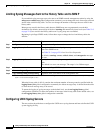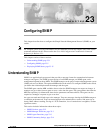
23-6
Catalyst 2950 Desktop Switch Software Configuration Guide
78-11380-05
Chapter 23 Configuring SNMP
Configuring SNMP
Default SNMP Configuration
Table 23-3 shows the default SNMP configuration.
SNMP Configuration Guidelines
An SNMP group is a table that maps SNMP users to SNMP views. An SNMP user is a member of an
SNMP group. An SNMP host is the recipient of an SNMP trap operation. An SNMP engine ID is a name
for the local or remote SNMP engine.
When configuring SNMP, follow these guidelines:
• When configuring an SNMP group, do not specify a notify view. The snmp-server host global
configuration command autogenerates a notify view for the user and then adds it to the group
associated with that user. Modifying the group's notify view affects all users associated with that
group. Refer to the Cisco IOS Configuration Fundamentals Command Reference for Release 12.1
for information about when you should configure notify views.
• To configure a remote user, specify the IP address or port number for the remote SNMP agent of the
device where the user resides.
• Before you configure remote users for a particular agent, configure the SNMP engine ID, using the
snmp-server engineID global configuration with the remote option. The remote agent's SNMP
engine ID and user password are used to compute the authentication and privacy digests. If you do
not configure the remote engine ID first, the configuration command fails.
• When configuring SNMP informs, you need to configure the SNMP engine ID for the remote agent
in the SNMP database before you can send proxy requests or informs to it.
• Changing the value of the SNMP engine ID has important side effects. A user's password (entered
on the command line) is converted to an MD5 or SHA security digest based on the password and the
local engine ID. The command-line password is then destroyed, as required by RFC 2274. Because
of this deletion, if the value of engineID changes, the security digests of SNMPv3 users become
invalid, and you need to reconfigure SNMP users by using the snmp-server user username global
configuration command. Similar restrictions require the reconfiguration of community strings when
the engine ID changes.
Table 23-3 Default SNMP Configuration
Feature Default Setting
SNMP agent Enabled
SNMP community strings Read-Only: Public
Read-Write: Private
Read-Write-all: Secret
SNMP trap receiver None configured
SNMP traps None enabled
SNMP version If no version keyword is present, the default is version 1.
SNMPv3 authentication If no keyword is entered, the default is the noauth (noAuthNoPriv)
security level.
SNMP notification type If no type is specified, all notifications are sent.


















